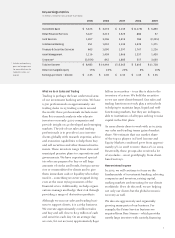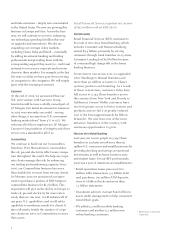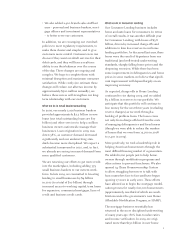JP Morgan Chase 2009 Annual Report Download - page 19
Download and view the complete annual report
Please find page 19 of the 2009 JP Morgan Chase annual report below. You can navigate through the pages in the report by either clicking on the pages listed below, or by using the keyword search tool below to find specific information within the annual report.17
ment programs and more than 20,000 training
programs (including online courses) that
enable our people to hone and expand their
skills in a rapidly changing business.
Ongoing assessment and development
At JPMorgan Chase, we are fortunate to attract
world-class talent. We owe it to our employees,
our customers and our shareholders to create
an environment in which our people can do
their best work. Toward this end, we believe
in assessing their strengths and weaknesses
and regularly giving them honest and thor-
ough feedback. Additionally, we know that
in order to sustain our strong competitive
position, we must focus on developing excep-
tional leaders. This starts with a clear and
shared understanding about the attributes we
value most in senior managers. These qualities
must be intentionally fostered and reinforced
through a rigorous talent assessment process.
This process now is embedded as part of how
we operate. We also are developing a general
management program for M.B.A. students to
help us add to our bench and build general
management talent on an ongoing basis.
Encouraging mobility and multiple careers
Talent mobility and optimization are key to our
long-term success. We have to clearly outline
what people need to do to move to the next
level at JPMorgan Chase. We are working to
do away with statements such as, “My boss
won’t let me go … or my boss won’t let me
look at positions in other divisions.” People
have the right to explore dierent career
opportunities and follow their dreams. While
it’s also an individual’s responsibility to
manage his or her own career, it’s our job to
help facilitate that. We strive to be proactive
and thoughtful in that regard.
Intense focus on succession
We need to be honest and thoughtful about
potential successors, particularly for senior
jobs. We have redoubled our eorts to
ensure that we have people in the pipeline
who are capable of assuming senior levels of
responsibility three, five or even seven years
out or right away if necessary (the “hit by a
truck” emergency scenario). This is true for
my job as well.
Poor CEO succession has destroyed many a
company. CEO and management succession
often seems more like a psychological drama
or a Shakespearean tragedy than the reasoned
and mature process it should be. It is in our
best interest to avoid such drama.
I want to assure you, our shareholders, that
your Board believes that we have within the
organization some outstanding people who
could do my job today; and we will continue to
rotate some of our senior people across the busi-
ness to ensure that others are fully developed to
take my job in the future. The Board of Direc-
tors not only believes that this is a priority but
that it is of the utmost importance. And you can
rest assured that your Board members are on
the case. They personally know all of the Oper-
ating Committee members of the company (and
many others), and the Board members peri-
odically review – with and without me – your
company’s key succession plans.
Getting compensation right
Compensation is one of the most complex
issues we confront – it is important to our
employees, our company, our shareholders
and, increasingly, the public at large. A poorly
conceived compensation strategy can devas-
tate a company by attracting the wrong people
and incenting them to do the wrong things
for the wrong reasons. At JPMorgan Chase,
we put a great deal of time and thought into
designing compensation plans that attract
and motivate good people and reward good
behavior. Of course, compensation aside, we
always expect our people to do the right thing.
A badly designed compensation plan never is
an excuse for bad behavior.
Many people are concerned and angry about
compensation practices across the finan-
cial services industry – and many of these
concerns are quite legitimate. Senior leaders
at some companies made a great deal of
























